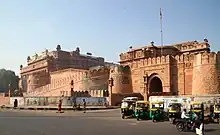| Raja Rai Singh | |
|---|---|
_-_1987.1100_-_Cleveland_Museum_of_Art_(cropped).jpg.webp) | |
| Raja of Bikaner | |
| Reign | 1571 – 1612 |
| Predecessor | Rao Kalyan Mal |
| Successor | Dalpat Singh |
| Born | 20th July 1541 |
| Died | 20th January 1612 Burhanpur Deccan Mughal Empire |
| Spouse | Sisodiniji Jaswant Deiji d.of Maharana Udai Singh I of Mewar
Bhatiyaniji Ganga Deiji d.of Maharawal Harraj Singh of Jaisalmer Tomarji Dhrupad Deiji of Lakhasar in Bikaner Parmarji (Sodhiji) Bhan Deiji of Amarkot Chauhanji (Nirbanji) Chatra Deiji of Khandela in Amber Bhatiyaniji Amolak Deiji of Jaisalmer |
| Issue | Sons:-
Bhupat Singh Dalpat Singh Sur Singh Hanwant Singh Kishan Singh Daughters:- Yash Kanwarji m.to Raja Veerbhadra Singh Ju Devji of Rewa Dev Kanwarji m.to Rana Rai Sinhji I of Halvad |
| House | Bikawat-Rathore |
| Father | Rao Kalyan Mal |
| Mother | Songariji (Chauhanji) Bhagwat Deiji d.of Rao Akhairaj of Jalore |
Raja Rai Singh was the sixth ruler of the Kingdom of Bikaner between 1571 and 1612. Bikaner was a vassal state of the Mughal Empire, and Raja Rai Singh was an important general and high ranking official after the Kachwaha rulers of Amber. He participated in the imperial Mughal campaigns in Gujarat and Malwa, and later served as the governor in Burhanpur and Lahore. One of his daughter was married to the Mughal Emperor Jahangir,she was senior to his another rajput queen from the Rathore house of Jodhpur.
Biography
_-_2021.11_-_Cleveland_Museum_of_Art.jpg.webp)
He was born in 1541. After the death of his father in 1571, Rai Singh assumed the rule of Bikaner. In 1576, when the emperor Akbar was visiting the shrine at Ajmer, he went there with 6000 horse and paid homage to the emperor.[1]
Subsequently, Rai went on to join the force against the Gujarat Sultanate. In the Gujarat campaign, Bikaneri forces suffered heavy losses. On the completion of the campaign, Rai Singh received the title of Raja as well as a grant of 52 parganas.[1]
In 1585, he was sent to Khandesh in the Deccan. Between 1587 and 1592, he was the general in command on the Deccan front. In 1593, when a large force was assembled against Burhan Nizam Shah II, he served as the principal advisor to Prince Daniyal Mirza. He was made the governor of Burhanpur.[2]
By the 1590s, tension had grown between Rai and the minister Karam Chand Bachhawat, who was at the helm of affairs in Bikaner while Rai served in imperial campaigns. In 1595, after a plot to assassinate Rai was discovered, Karam Chand had to flee Bikaner.[3]
In 1604, the emperor Akbar died and Jahangir ascended the Mughal throne. The same year, Karam Chand also died. Rai was once again dispatched as governor to Burhanpur, where he proceeded with his son Sur Singh. In 1612, he died in Burhanpur. Three of his queens and three concubines performed sati on his pyre.[4]
Legacy

Rai was among the highest ranked Hindu nobles of the Mughal court. His reign is regarded as a turning point in the history of Bikaner. Revenues from the fiefs granted to the Rai, as well as war exploits made the state wealthy. The capital grew into an opulent town, and several important buildings were commissioned. These include the Junagarh Fort. Exploits from the campaigns, including idols from Gujarat and Sirohi, as well as miniature paintings collected by Rai, were brought back to Bikaner. During his reign, a rudimentary school of painting developed which evolved into the Bikaner school.[5]
References
- 1 2 Powlett 1874, p. 22.
- ↑ Goetz 1950, p. 41.
- ↑ Jain, Shalin (2007). "The Centre and the 'Locality' in Mughal India: The Case of Mantri Karam Chand Bachhawat of Bikaner". Proceedings of the Indian History Congress. 68: 332–339. ISSN 2249-1937.
- ↑ Powlett 1874, p. 28.
- ↑ Goetz 1950, p. 43.
Bibliography
- Sehgal, K. K. (1962). Rajasthan Distict Gazetteers: Bikaner. Jaipur: Bharat Printers.
- Powlett, P. W. (1874). Gazetteer of The Bikaner State.
- Goetz, Herman (1950). Art and Architecture of Bikaner State. Bruno Cassirer.